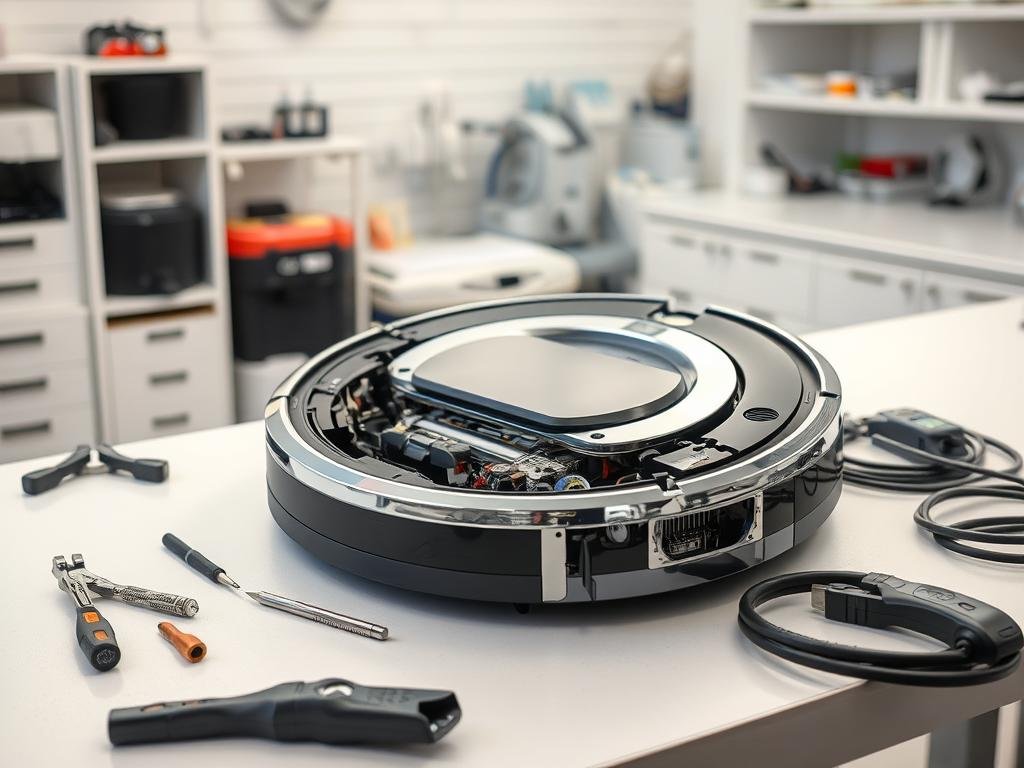The market for automatic floor cleaning devices in the United States is growing fast. It was worth about $130 million in 2023. Experts predict it will hit $145.48 billion by 2025 and maybe $284 million by 2030. This growth shows how vital it is to keep your robot vacuum cleaner in top shape.
When it comes to caring for your device, knowing your options is key. Professional repair services start at around $100, plus the cost of parts. But, you can also do some repairs yourself, like changing batteries, brushes, and filters, and cleaning sensors and wheels. For tougher problems, you might need to see a professional repair service.
Introduction to Robot Vacuum Cleaners
Robot vacuum cleaners are changing how we clean our homes. They make vacuuming floors easy, so you can keep your home clean with little effort.
What is a Robot Vacuum Cleaner?
A robot vacuum cleaner, or smart vacuum robot, cleans your floors by itself. It uses advanced sensors and cleaning tech to clean hardwood, carpet, and tile floors.
How Does a Robot Vacuum Work?
A robot vacuum for your home uses sensors and navigation to map and clean your space. It has strong suction and different cleaning modes for various tasks. Knowing how they work helps you choose the right one.
“Robot vacuums are amazing because they clean your home without you,” says a home automation expert. “They’re great for busy people or anyone who wants a clean home easily.”
Benefits of Using a Robot Vacuum Cleaner
Robot vacuum cleaners save you time and effort. They also improve your home’s air quality by reducing dust and allergens. Plus, many models connect to Wi-Fi, letting you control and schedule cleanings from your phone.
Some main benefits of a robotic vacuum for home include:
- Efficient cleaning of various floor types
- Advanced navigation and mapping technologies
- Improved indoor air quality
- Remote control and scheduling capabilities
Choosing the Right Robot Vacuum Cleaner
To find the perfect self-navigating vacuum, you need to look at several things. These include the type of flooring, your home’s size, your budget, and if you have pets. Each of these factors is important when picking a robot vacuum.
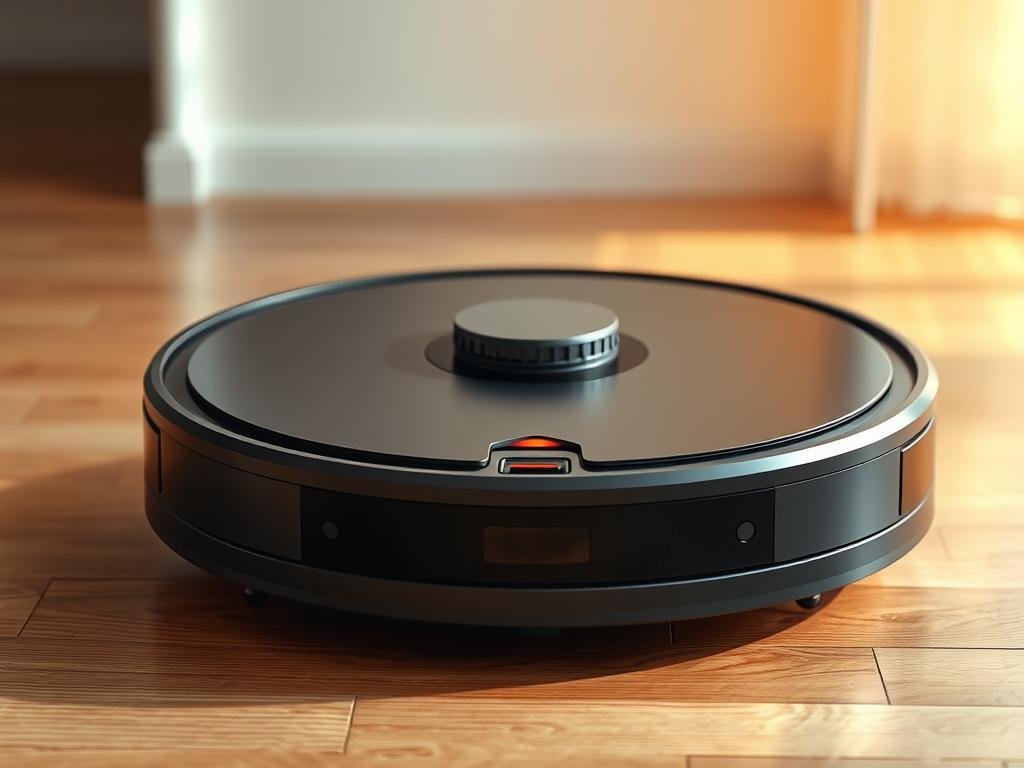
Key Features to Consider
There are key features that can make a big difference in your robot vacuum cleaner. These include:
- Navigation technology: Look for models with advanced mapping capabilities.
- Battery life: Consider how long the vacuum can operate on a single charge.
- Suction power: Evaluate the vacuum’s ability to clean different surfaces effectively.
- Smart home integration: Check if the vacuum is compatible with your existing smart home systems.
- Maintenance requirements: Understand how to clean and maintain the vacuum’s sensors and brushes.
Popular Brands and Models
Some top brands in the robot vacuum cleaner market are iRobot, Ecovacs, and Neato Robotics. They offer a variety of models with different features. For example:
- iRobot’s Roomba series is known for its reliable navigation and cleaning performance.
- Ecovacs’ Deebot models often feature advanced navigation and affordable pricing.
- Neato Robotics offers models with unique D-shape designs for better corner cleaning.
Customer Reviews and Recommendations
Customer reviews offer valuable insights into a robot vacuum cleaner‘s performance. Look for reviews that talk about the product’s good and bad points. Also, listen to recommendations from friends, family, or online communities.
By considering these factors and doing your homework, you can find the best automated vacuum cleaner for your home.
Common Issues with Robot Vacuum Cleaners
Robot vacuum cleaners are meant to make cleaning easier. But, like any device, they can have problems. Knowing these common issues can help you fix them. This way, your intelligent floor cleaning robot will keep working well.
Battery Problems
Battery issues are a common problem with robot vacuums. If your robot vacuum can’t hold a charge or dies fast, it might have a bad battery or charging issues. Check your charging dock to make sure it’s working right. For more help, visit Ecovacs’ blog.
Navigation Failures
Navigation problems can make your robot vacuum get stuck or not map your space right. This might be because of sensor issues, software bugs, or physical blocks. Keep the sensors clean and make sure your space is clear. For bigger problems, you might need to reset your device or update its software.
Dust Bin and Filter Issues
A clogged dust bin or dirty filter can really hurt your robot vacuum’s performance. It’s important to empty the dust bin and clean or replace the filter regularly. Always check your user manual for the best way to take care of these parts.
| Issue | Cause | Solution |
|---|---|---|
| Battery Problems | Faulty battery, improper charging | Check charging dock, replace battery if necessary |
| Navigation Failures | Sensor issues, software glitches, obstructions | Clean sensors, reset device, update software |
| Dust Bin and Filter Issues | Clogged dust bin, dirty filter | Empty dust bin, clean or replace filter |
By knowing and fixing these common problems, you can keep your robot cleaner for carpets working great. Regular care and troubleshooting can make your device last longer. This ensures it keeps giving you the convenience you need.
Troubleshooting Basic Issues
Fixing your robot vacuum might seem hard, but it’s easier than you think. You can solve common problems with a few simple steps. This guide will help you tackle navigation issues and error messages.
Step-by-Step Troubleshooting
To begin fixing your robot vacuum and mop, just follow these steps:
- Check for blockages: Make sure there’s nothing blocking the vacuum’s path or sensors.
- Clean the sensors: Dirty sensors can mess up navigation. Use a soft cloth to clean them.
- Update the software: Make sure your vacuum has the latest software. Updates often fix problems.
By doing these steps, you can usually fix common problems. Your best robotic vacuum will work like new again.
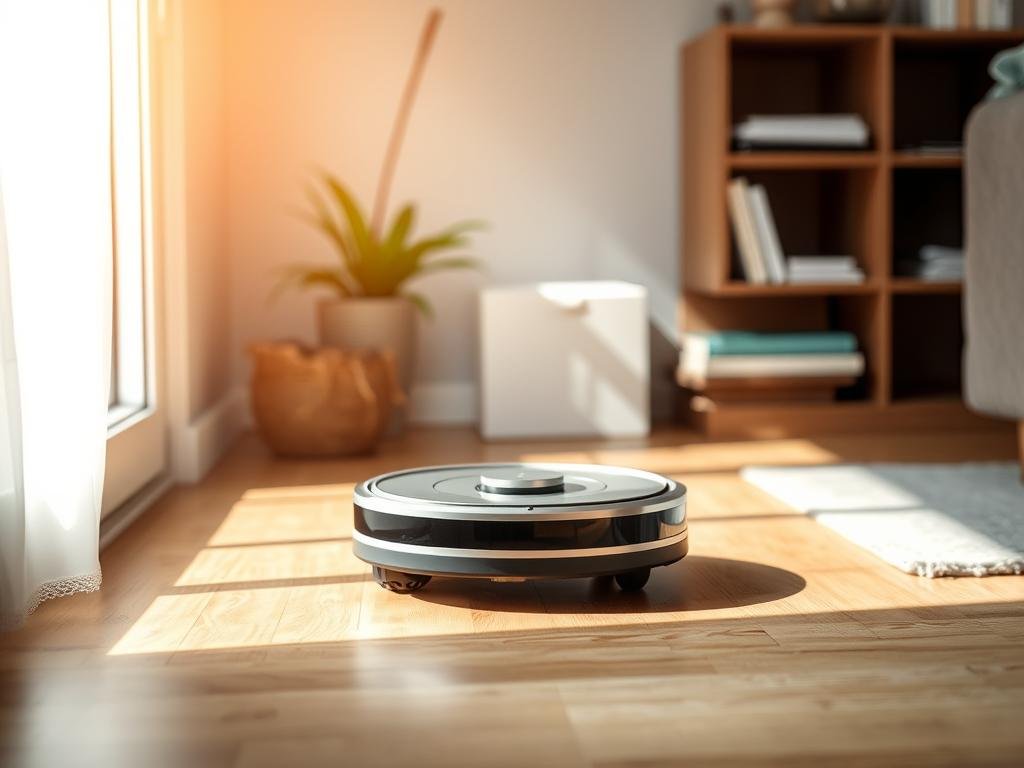
When to Perform a Factory Reset
A factory reset might solve ongoing issues with your robot vacuum. Try it if:
- You’ve tried basic fixes but nothing works.
- The vacuum keeps showing errors or freezing.
- You’re about to sell or give away the vacuum.
To reset your vacuum, check your user manual or the manufacturer’s website. The steps can differ.
Common Error Codes Explained
Robot vacuums show error codes when they have problems. Here’s what some common codes mean:
| Error Code | Description | Solution |
|---|---|---|
| E01 | Wheels are stuck or blocked. | Check and clean the wheels. |
| E02 | Sensor issue. | Clean the sensors or contact support. |
Knowing these error codes helps you quickly find and fix problems. Your robot vacuum and mop will keep working well.
Sensor Problems and Solutions
Your smart vacuum robot uses sensors to move and clean. These sensors help it avoid obstacles and stairs. This ensures it works safely and well.
Types of Sensors in Robot Vacuums
Robot vacuums have different sensors. These include:
- Cliff sensors: These stop the robot from falling down stairs.
- Bumper sensors: These detect when the robot hits something and help it move around furniture.
- Infrared sensors: These find obstacles and help with navigation.
- Lidar or camera modules: These advanced sensors map out the space for better cleaning routes.
Knowing what sensors your robot vacuum has can help you fix problems.
Diagnosing Sensor Malfunctions
If your robot vacuum is not moving right or is avoiding areas, it might have a sensor problem. To find out:
- Look for dirt or debris on the sensors, as this often causes problems.
- Make sure the sensors are properly aligned and not blocked.
- Check your user manual for troubleshooting guides for your model.
Cleaning the sensors regularly can stop many issues. This keeps your robot vacuum working well.
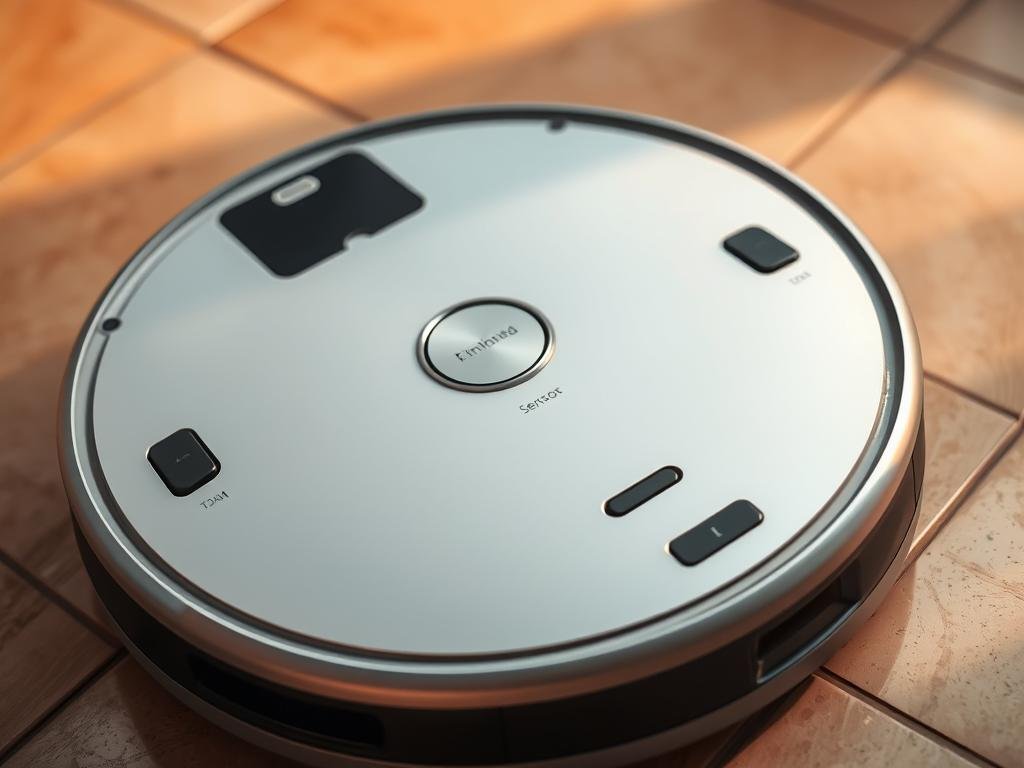
Repair or Replace?
After finding a sensor problem, you must choose to repair or replace it. For some, replacing a sensor is easy and cheap. But for others, with complex systems, you might need a pro.
Think about the cost of replacement parts and the complexity of the repair. Sometimes, it’s cheaper to get a new robot vacuum if repair costs are too high.
Maintenance Tips for Optimal Performance
Regular upkeep is key to making your robot vacuum last longer. To keep your robotic vacuum for home running well, follow some easy maintenance tips.
Regular Cleaning and Care
It’s important to keep your robot vacuum clean for it to work right. Clean the sensors and brushes often to avoid navigation problems and get a better clean. Always empty the dust bin after each use and clean the filters regularly.
- Clean the sensors and charging contacts regularly
- Wipe the exterior with a damp cloth
- Check and clean the brushes and wheels
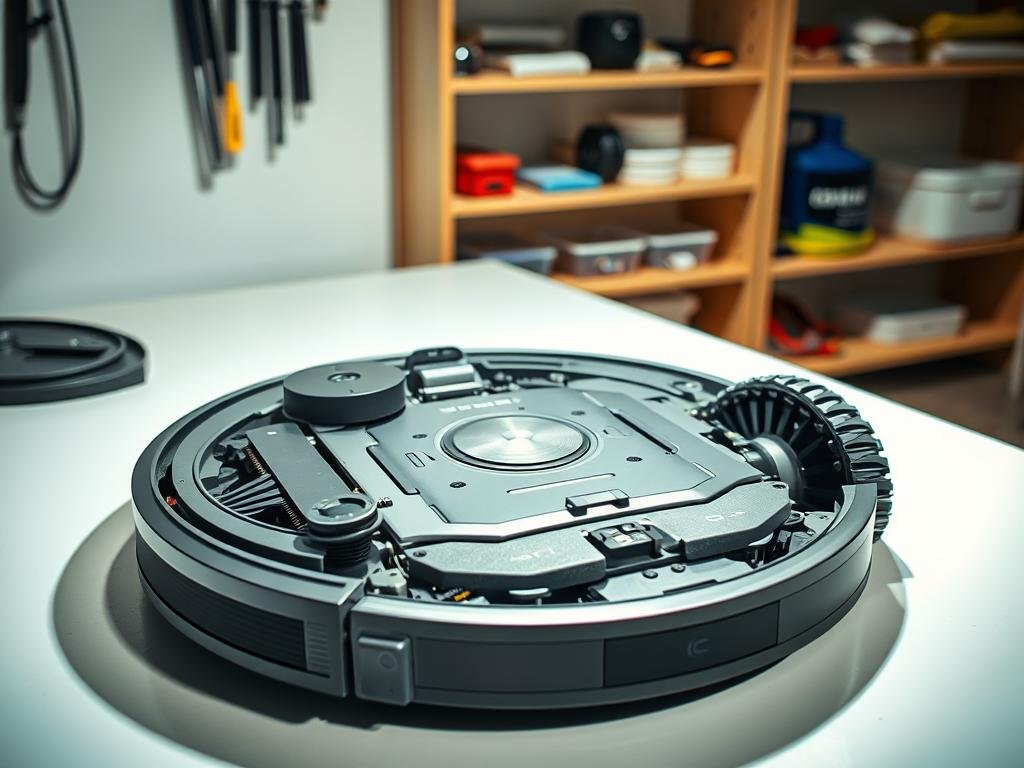
Software Updates
Your self-navigating vacuum needs software updates to work better and fix bugs. Check for updates in the app from the maker and follow the steps to update your device.
- Open the manufacturer’s app on your smartphone
- Navigate to the settings or software update section
- Follow the prompts to download and install the update
Battery Maintenance
Looking after your robot vacuum’s battery is important. Don’t let the battery run out all the time, and keep it away from very hot or cold places. For a self-navigating vacuum, keeping the battery healthy is key for continuous cleaning.
- Avoid deep discharges when possible
- Keep the robot vacuum away from extreme temperatures
- Update your device regularly to ensure optimal battery performance
DIY Repairs for Robot Vacuum Cleaners
DIY repairs can make your intelligent floor cleaning robot work like new again. They save you money and make your robot last longer. Many problems can be fixed at home with the right tools and a little bit of knowledge.
Tools Needed for Repairs
Before starting any DIY repair, you need the right tools. You’ll need a Phillips screwdriver, a flathead screwdriver, and a cleaning brush. Depending on the problem, you might also need a new battery or other parts.
- Phillips screwdriver
- Flathead screwdriver
- Cleaning brush
- Replacement parts (e.g., battery, brushes)
How to Replace the Battery
Replacing the battery in your robot vacuum is easy if you follow the steps. First, get a battery that fits your robot. Then, follow these steps:
- Turn off your robot vacuum and flip it over.
- Remove the screws holding the battery cover in place.
- Gently pry open the cover and disconnect the battery.
- Connect the new battery and reassemble everything.
Tip: Always check your user manual or the manufacturer’s instructions for specific battery replacement steps for your model.
Fixing Navigation Issues at Home
Navigation problems can often be fixed by cleaning the sensors and removing any blockages. Here’s how to troubleshoot:
- Clean the sensors with a soft cloth.
- Check for and remove any obstructions or debris.
- Restart your robot vacuum to reset its navigation system.
If the problem doesn’t go away, you might need to look at the user manual or contact the manufacturer for help.
| Issue | DIY Solution |
|---|---|
| Battery Problems | Replace the battery |
| Navigation Failures | Clean sensors, remove obstructions |
| Dust Bin and Filter Issues | Clean or replace the filter, empty the dust bin |
“The best way to get started is to quit talking and begin doing.” – Walt Disney
This quote shows the DIY spirit. It encourages you to take action and fix your robot vacuum instead of calling a professional right away.
When to Seek Professional Repair
If your robot vacuum cleaner has complex problems, it’s time to call a pro. While you can fix many issues yourself, some need a technician’s skills.
Signs You Need Expert Help
Here are signs you should get expert help:
- Complex problems you can’t figure out or fix.
- Issues that need special tools or equipment.
- If your device is under warranty, DIY repairs could void it.
- Persistent problems that won’t go away after basic troubleshooting.
As Consumer Reports says, “For complex repairs, a pro is best to avoid more damage to your device.”
Cost of Professional Repairs
The cost of professional repairs varies. You might pay about $100 plus part costs. Always get a quote first to make sure it’s fair.
How to Find a Qualified Technician
To find a good technician, follow these steps:
- Check the manufacturer’s website for authorized services.
- Read online reviews to see if local services are good.
- Ask friends, family, or online forums for recommendations.
- Make sure the technician knows your robot vacuum brand and model.
By following these tips, you can get your robot vacuum fixed right. This will make it last longer and work better.
Repairing Specific Brands
Keeping your robot vacuum in top shape is more than just basic troubleshooting. It’s about knowing the specific needs of your brand. Each brand has its own design, features, and repair needs. It’s important to understand these differences to keep your vacuum running smoothly.
iRobot Roomba Repair Guidelines
iRobot Roomba vacuums are favorites for their dependability and smart navigation. But, like any tech, they can run into problems. Issues like navigation failures and battery drain are common. For detailed troubleshooting, the iRobot community forum is a great resource.
- Regularly clean the sensors and brushes to prevent navigation issues.
- Update your Roomba’s software regularly to ensure you have the latest features and fixes.
- Check the battery health and replace it when necessary to maintain performance.
Ecovacs Deebot Maintenance Tips
Ecovacs Deebot vacuums are known for their smart navigation and strong suction. To keep them in top shape, clean the dust bin and filters regularly. Also, make sure to update the software. Keeping the sensors clean is key for good navigation.
- Clean the main brush and side brushes regularly.
- Check and clean the filters to maintain suction power.
- Update the device’s software to the latest version.
Neato Robotics Common Repairs
Neato Robotics vacuums use laser navigation, which can have specific problems. Common fixes include replacing the laser system and addressing battery issues.
Key maintenance tips for Neato Robotics include:
- Regularly inspect and clean the laser navigation system.
- Check for firmware updates to improve performance and fix known issues.
- Replace the battery as needed to maintain the device’s effectiveness.
By following these brand-specific tips, you can keep your robot vacuum in great shape. This ensures a cleaner home with less effort from you.
Warranty and Insurance Considerations
It’s important to know about warranties and insurance for your automatic floor cleaner. Owning a smart vacuum robot is more than just buying a product. It’s investing in a technology that makes your life easier. But, like any electronic, it can break or get damaged, so you need to think about warranty and insurance.
Understanding Your Warranty
First, learn what your warranty covers. Most makers offer a limited warranty for a year or two. This warranty includes repairs and replacements for parts and labor. It’s key to read the fine print and know what’s included and what’s not.
Key aspects to look for in your warranty include:
- Duration of the warranty
- Parts and labor covered
- Conditions that void the warranty
What Repairs Are Covered?
Not all repairs are the same. It’s important to know what your warranty covers. Usually, it covers manufacturing defects and some malfunctions. But, damages from misuse, accidents, or wear and tear are not included. Knowing this can help you budget for repairs and avoid surprises.
For example: If your robot’s battery fails within the warranty, it might be covered. But, if the damage is from misuse, like water damage, it might not be.
Benefits of Extended Warranty Plans
Extended warranty plans offer more protection than the standard warranty. They can give you peace of mind, which is important for a big investment like a smart vacuum robot. When looking at an extended warranty, think about the cost, coverage, and how long it lasts. Decide if it’s worth it for your automatic floor cleaner.
| Plan | Duration | Coverage | Cost |
|---|---|---|---|
| Standard Warranty | 1-2 years | Manufacturing defects | Included |
| Extended Warranty | 2-5 years | Parts and labor, accidental damage | Additional fee |
By understanding your warranty and insurance options, you can make smart choices about your smart vacuum robot. This way, you can enjoy your automatic floor cleaner with confidence.
Conclusion
Maintaining and fixing your robotic vacuum is key for it to work well. Knowing how to solve common problems can make your vacuum last longer. This way, your self-navigating vacuum will keep your home clean.
Key Takeaways
We’ve talked about picking the right robotic vacuum and fixing simple issues. We also covered DIY repairs and the importance of regular upkeep. Keeping your vacuum’s sensors clean and updating its software are musts for it to work right.
Advancements in Robot Vacuum Technology
The future of robot vacuums is bright. They will get better at navigating, sucking up dirt, and being smart. These improvements mean your vacuum will clean even better and fit into your daily routine more smoothly.
Final Considerations
By using the advice from this article, you’ll have a hassle-free cleaning experience. Keeping up with maintenance and fixing problems quickly is vital. This ensures your vacuum stays reliable and keeps your home spotless.
FAQ
What is a robot vacuum cleaner and how does it work?
A robot vacuum cleaner is a device that cleans your floors by itself. It moves around your home using sensors and navigation systems. It finds dirt and cleans it with its built-in vacuum.
How do I choose the right robot vacuum cleaner for my home?
To pick the right robot vacuum, think about your floors, home size, and what features you want. Look for Wi-Fi, voice control, and pet hair handling. Read reviews and compare models.
Why is my robot vacuum cleaner not charging?
If your robot vacuum won’t charge, check the power cord and charging dock. Make sure the contacts are clean and the battery is right.
How do I troubleshoot navigation issues with my robot vacuum?
To fix navigation problems, check for blockages and update the firmware. Reset it if needed. Clean the sensors and reboot the device.
Can I repair my robot vacuum cleaner’s sensors myself?
Yes, you can fix or replace some sensors yourself. It depends on the sensor and your vacuum’s model. Check your manual or contact the maker for DIY help.
How often should I clean and maintain my robot vacuum cleaner?
Clean the dust bin, filters, and sensors often for best performance. Update the software regularly. Do a deep clean every few months.
What are the benefits of extended warranty plans for my robot vacuum?
Extended warranties offer extra protection against repairs and replacements. They give you peace of mind and can save you money on repairs.
How do I know if my robot vacuum cleaner is stil under warranty?
Check your manual or contact the manufacturer to see if your vacuum is under warranty. You might need to give your device’s serial number or purchase date.
Can I use my robot vacuum cleaner on different floor types, such as carpets and hardwood?
Most robot vacuums work on various floors, but some are made for specific surfaces. Make sure your vacuum is right for your floors.
What are some common error codes for robot vacuum cleaners, and how do I resolve them?
Error codes vary by model but often mean navigation, sensor, or battery problems. Check your manual or contact the maker to understand and fix the issue.
